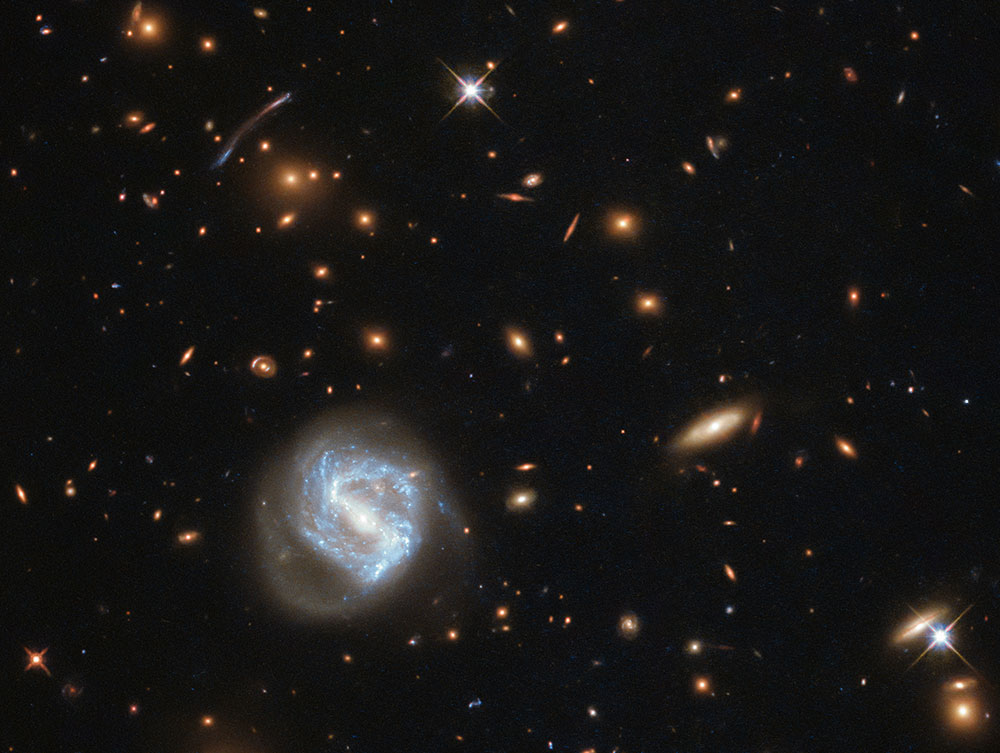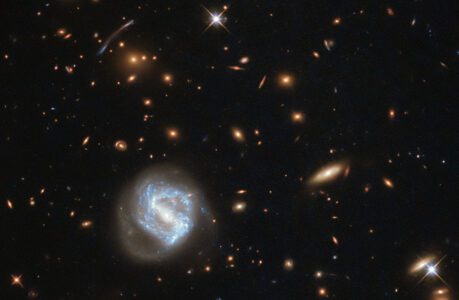Unveiling the Hidden Gems of Our Galactic Neighborhood
The universe is a vast and mysterious place, filled with countless galaxies, each with its own unique story to tell. In this cosmic tapestry, our Milky Way and the Andromeda Galaxy stand out as two of the most prominent members of our cosmic neighborhood, known as the Local Group. But have you ever wondered if there are any other galaxies lurking within this group, waiting to be discovered and explored? Join us on an exhilarating journey through space as we unveil the hidden gems beyond our Milky Way and Andromeda.
The Local Group: Our Cosmic Neighborhood
Before we dive into the depths of our cosmic backyard, let’s take a moment to understand what the Local Group is and why it’s so significant in the grand scheme of the universe.
What Is the Local Group?
The Local Group is a small cluster of galaxies bound together by gravity. It’s like a close-knit family of cosmic bodies, where galaxies interact with each other through gravitational forces over cosmic timescales. The two most prominent members of this group are our very own Milky Way and the neighboring Andromeda Galaxy. However, the Local Group is not limited to just these two galaxies; it includes numerous other, smaller galaxies, some of which are quite fascinating.
The Importance of the Local Group
Studying the galaxies within the Local Group is essential for several reasons. Firstly, it provides a unique opportunity to explore galaxies relatively close to us, allowing for detailed observations that are often not possible for more distant galaxies. Secondly, understanding the dynamics of the Local Group can shed light on the broader structure of the universe and the distribution of galaxies on a larger scale. Lastly, it offers valuable insights into the formation and evolution of galaxies, including our own Milky Way.
Now that we have a basic understanding of the Local Group, let’s embark on our journey to uncover the lesser-known galaxies that call it home.
1. Triangulum Galaxy (M33): The Third Musketeer
While Milky Way and Andromeda are the celestial celebrities of the Local Group, the Triangulum Galaxy, also known as Messier 33 (M33), deserves its own share of the limelight. This spiral galaxy, located approximately 2.7 million light-years away, is the third-largest member of our cosmic neighborhood.
Characteristics of the Triangulum Galaxy
M33 is a stunning spiral galaxy that boasts a beautiful, well-defined structure. It is smaller and less massive than both the Milky Way and Andromeda, making it a fascinating subject of study. Some key features of this galactic gem include:
- Spiral Arms: Like the Milky Way, M33 exhibits spiral arms that wrap around its central bulge. These arms are adorned with young, hot stars and regions of active star formation.
- Satellite Galaxies: Just as the Milky Way has its entourage of satellite galaxies, M33 is accompanied by a handful of smaller galaxies, including dwarf galaxies and globular clusters.
- H II Regions: The Triangulum Galaxy is rich in H II regions, which are regions of ionized hydrogen gas where new stars are born. These regions are visible as colorful patches of nebulosity.
Significance in the Local Group
Studying M33 provides valuable insights into the dynamics of galaxies within the Local Group. Its proximity allows astronomers to examine the interactions and gravitational influences between M33, the Milky Way, and Andromeda. Additionally, M33 serves as a valuable comparative model for understanding the formation and evolution of spiral galaxies.
2. The LMC and SMC: Milky Way’s Cosmic Companions
While not full-fledged galaxies in the traditional sense, the Large Magellanic Cloud (LMC) and the Small Magellanic Cloud (SMC) are two prominent members of the Local Group that orbit the Milky Way. These irregular dwarf galaxies play crucial roles in shaping the dynamics of our cosmic neighborhood.
Characteristics of the Magellanic Clouds
The LMC and SMC are two of the most easily visible galaxies from the Southern Hemisphere. They exhibit the following distinctive characteristics:
- Irregular Shape: Unlike the Milky Way and Andromeda, the LMC and SMC lack well-defined spiral arms. Instead, they have irregular shapes, resulting from gravitational interactions and tidal forces.
- Star Formation: Both clouds are active regions of star formation, with young stars scattered across their surfaces. They also contain H II regions and nebulae, where new stars are born.
- Satellites: Just as the Milky Way has its satellite galaxies, the LMC and SMC have their own set of smaller companions. These include the likes of the Tarantula Nebula and the 47 Tucanae globular cluster.
Role in Galactic Evolution
The Magellanic Clouds are essential players in the Milky Way’s cosmic drama. Their gravitational interactions with our galaxy have a profound impact on our galactic structure. These interactions can trigger the formation of new stars, disrupt existing stellar populations, and potentially contribute to the growth of the Milky Way’s dark matter halo.
3. The Milky Way’s Satellite Galaxies
Beyond the Magellanic Clouds, the Milky Way has a diverse entourage of satellite galaxies that orbit around it. These small galactic companions are intriguing in their own right and contribute to our understanding of galactic dynamics and the dark matter distribution in the Local Group.
Diverse Satellite Galaxies
The Milky Way’s satellite galaxies come in various shapes and sizes, from dwarf elliptical galaxies to dwarf spheroidal galaxies. Some of the most notable members of this group include:
- Large Magellanic Cloud (LMC): We’ve already discussed the LMC as one of the Magellanic Clouds, but its significance as a satellite of the Milky Way cannot be overstated. It is the most massive and gravitationally bound to our galaxy.
- Small Magellanic Cloud (SMC): Similarly, the SMC is a crucial satellite galaxy, though it is smaller and less massive than the LMC.
- Sagittarius Dwarf Spheroidal Galaxy: This galaxy, located in the constellation Sagittarius, is another important satellite of the Milky Way. It’s known for its complex orbit and its role in disrupting the Milky Way’s stellar halo.
- Canis Major Dwarf Galaxy: This relatively obscure dwarf galaxy is one of the closest to the Milky Way and has a mysterious history of interactions with our galaxy.
- Leo I and Leo II Dwarf Galaxies: These galaxies, found in the constellation Leo, are examples of dwarf spheroidal galaxies that orbit the Milky Way. They are valuable for studying the distribution of dark matter in the Local Group.
Contributions to Dark Matter Studies
One of the most intriguing aspects of these satellite galaxies is their potential to help us unravel the mystery of dark matter. Dark matter is an invisible, mysterious substance that makes up a significant portion of the universe’s mass. By studying the motions of stars within these satellite galaxies, astronomers can gain insights into the distribution and properties of dark matter in the Local Group.
4. NGC 6822: The Barnard’s Galaxy
Moving away from the Milky Way’s immediate vicinity, we find NGC 6822, a small, irregular dwarf galaxy commonly known as the Barnard’s Galaxy. This unassuming cosmic neighbor is situated approximately 1.6 million light-years away from us and is a captivating subject of study.
Distinctive Features of NGC 6822
NGC 6822 stands out due to several remarkable characteristics:
- Irregular Shape: As an irregular dwarf galaxy, NGC 6822 lacks the structured spiral arms seen in galaxies like the Milky Way. Instead, it has a more chaotic, irregular shape.
- Star Formation: The Barnard’s Galaxy is a hotbed of star formation, with numerous young, massive stars illuminating its outskirts.
- H II Regions: Similar to other galaxies rich in star formation, NGC 6822 boasts numerous H II regions, where newborn stars ionize the surrounding hydrogen gas.
Importance in Galactic Evolution
Studying galaxies like NGC 6822 provides insights into the processes of galaxy formation and evolution. Irregular dwarf galaxies, like this one, can help astronomers understand how galaxies with different shapes and structures evolve over cosmic time. Additionally, the Barnard’s Galaxy serves as a valuable testbed for studying the effects of stellar feedback and the chemical enrichment of the interstellar medium.
5. M32 and M110: Andromeda’s Satellites
As we turn our attention back to Andromeda, we discover that it, too, has its own set of satellite galaxies, similar to the Milky Way. Two notable companions of the Andromeda Galaxy are M32 and M110, each with its own unique characteristics and significance.
M32: A Compact Companion
M32 is a compact elliptical galaxy that orbits Andromeda at a relatively close distance. Some key features of M32 include:
- Small Size: M32 is significantly smaller than Andromeda, with a diameter of only about 8,000 light-years.
- Elliptical Shape: Unlike the spiral structure of Andromeda, M32 has an elliptical shape, with a concentration of stars toward its center.
- Dense Nucleus: The galaxy’s dense nucleus is home to an old population of stars.
M110: A Dwarf Elliptical
M110, also known as NGC 205, is a dwarf elliptical galaxy that accompanies Andromeda. Its notable characteristics include:
- Dwarf Elliptical: M110 is classified as a dwarf elliptical galaxy, which means it lacks the spiral arms and the pronounced features of larger galaxies.
- Satellite of Andromeda: Just like M32, M110 is a satellite of the Andromeda Galaxy, orbiting it at a greater distance.
- Stellar Population: M110 contains an older stellar population, making it an intriguing subject for studying the age and composition of stars in dwarf galaxies.
Studying Andromeda’s Companions
M32 and M110 provide astronomers with valuable opportunities to study the dynamics of satellite galaxies in a larger galactic system. Their interactions with the massive Andromeda Galaxy can reveal insights into the gravitational forces at play within the Local Group and the role of satellite galaxies in the evolution of larger galaxies.
The Quest for More Hidden Galaxies
While we’ve delved into five intriguing galaxies within our Local Group, it’s important to note that the quest for understanding our cosmic neighborhood is ongoing. Astronomers continue to explore the depths of space, searching for hidden galaxies and studying the known ones in greater detail. The Local Group, with its diverse collection of galaxies, serves as a captivating laboratory for unraveling the mysteries of the universe.
Beyond Our Cosmic Backyard
As technology advances and our observational capabilities improve, we can look forward to more exciting discoveries beyond the Milky Way and Andromeda. Whether it’s uncovering the secrets of dwarf galaxies, understanding the role of satellite galaxies, or shedding light on the enigmatic dark matter, the Local Group remains a treasure trove of cosmic wonders waiting to be explored.
In conclusion, our journey through the Local Group has introduced us to a captivating array of galaxies, each with its own unique characteristics and significance. From the spiral beauty of M33 to the enigmatic depths of NGC 6822, and from the Magellanic Clouds to the satellite galaxies of the Milky Way and Andromeda, our cosmic neighborhood continues to astound and inspire us. As we gaze into the night sky, we can’t help but wonder what other celestial treasures await our discovery in the vast expanse of the universe. The adventure continues, and the cosmos beckons us to explore further into its depths, unveiling the secrets of galaxies both near and far.

